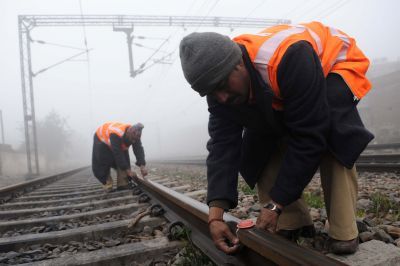India earmarks 9 billion dollars for rail expansion

Your support helps us to tell the story
From reproductive rights to climate change to Big Tech, The Independent is on the ground when the story is developing. Whether it's investigating the financials of Elon Musk's pro-Trump PAC or producing our latest documentary, 'The A Word', which shines a light on the American women fighting for reproductive rights, we know how important it is to parse out the facts from the messaging.
At such a critical moment in US history, we need reporters on the ground. Your donation allows us to keep sending journalists to speak to both sides of the story.
The Independent is trusted by Americans across the entire political spectrum. And unlike many other quality news outlets, we choose not to lock Americans out of our reporting and analysis with paywalls. We believe quality journalism should be available to everyone, paid for by those who can afford it.
Your support makes all the difference.India's government announced plans to spend a record nine billion dollars this year to modernize and expand Asia's largest rail network and promised high-speed trains for the future.
"We will have to move faster to connect peoples and places across this nation," Railways Minister Mamata Banerjee said, as she unveiled the railway's budget for the fiscal year to March 2011 in parliament.
She underscored the government's populist focus by leaving passenger fares unchanged. She also cut freight rates for kerosene - used widely for cooking by the poor - and food grains, a step that could ease soaring food inflation.
The railway budget is keenly watched by analysts as setting the tone for the national budget, due Friday, that is expected to have a "common man" theme.
The railway is the "lifeline of the nation," said the minister, a feisty figure in the left-leaning Congress-led coalition who casts herself as a champion of the poor.
India announces a separate budget for its railway because of the size of the network with its 17,000 trains.
It is still the main form of passenger and freight transport in the country of 1.2 billion people despite fierce competition from new private airlines.
Banerjee announced the government would boost spending by three percent to 414 billion rupees (nine billion dollars) to upgrade the dilapidated 157-year-old railway built by India's former British colonial rulers.
"Our goal is to unite the country with connectivity," Banerjee said as she announced dozens of new trains for this year and laid out an ambitious plan, "Vision 2020," for the coming decade.
The scheme included plans for dedicated high-speed passenger train corridors - to be known as the "Golden Rail Corridor" - similar to an existing freight network.
She said the high-speed trains, to be introduced "in the coming years," would reach speeds of up to 350 kilometres (217 miles) an hour and serve as a catalyst for economic growth.
India's neighbour and rival China has already embarked on an ambitious plan to build 13,000 kilometres of high-speed track by 2012 as it seeks to sustain its rapid economic growth.
The Vision 2020 plan also included adding 25,000 kilometres to the current route length of 64,000 kilometers - this compares with an addition of 10,400 kilometres during the last five decades.
Banerjee ruled out privatisation to raise funds but appealed to industry to join hands with the government in a "public-private partnership" to improve the network and said there was a need to make policies "investment friendly".
She promised a special task force to clear investment proposals in 100 days, where they can currently take many months or even years.
Analysts were sceptical about the speed at which plans would be carried out.
But even if half were implemented, the railway "could see a dramatic transformation from a colonial era rail transport company to a modern and technologically upgraded, passenger-friendly rail transport," said Religare analyst Jay Shankar.
pmc/hg
Join our commenting forum
Join thought-provoking conversations, follow other Independent readers and see their replies
Comments